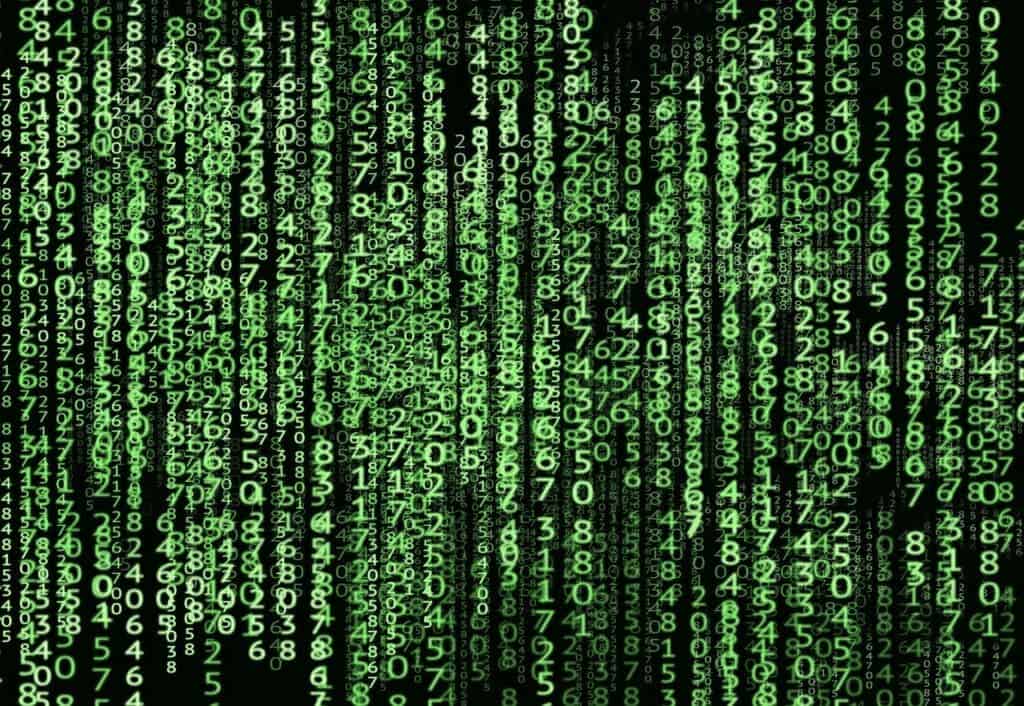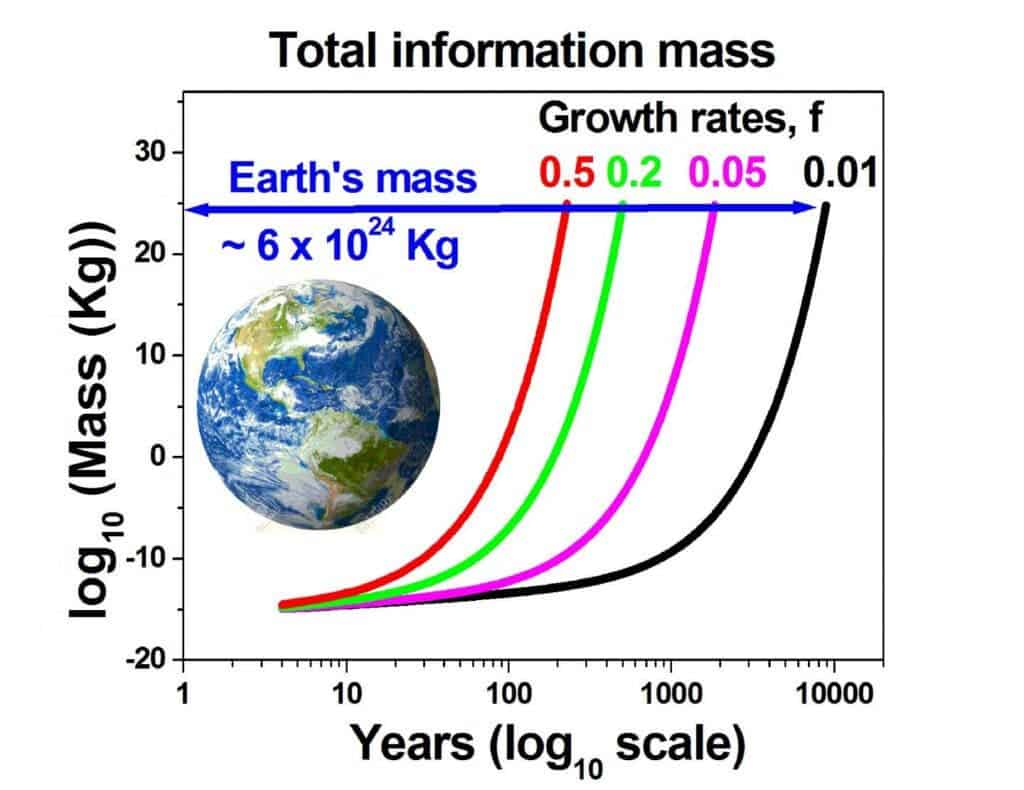
All the matter that surrounds us exists either as a solid, liquid, gas, or plasma. But as our lives become increasingly digitized, more and more physical matter, such as oil, silicon, and carbon, is required to sustain our insatiable need for more computing power and information processing.
Giving current trends of 50% annual growth in the number of digital bits produced, Melvin Vopson, a physicist at the University of Portsmouth in the UK, forecasted that the number of bits would equal the number of atoms on Earth in approximately 150 years. By 2245, half of Earth’s mass would be converted to digital information mass, according to a study published today in AIP Advances.
It’s just a matter of time before digital bits outnumber all the atoms on Earth, a future in which the world is converted into a planetary-sized supercomputer — and all of this leads to an enticing theory: that information is no different from ordinary matter. In fact, Vopson says, the information should be considered the fifth state of matter (or sixth if you count Bose-Einstein condensates).
“How can information, a mathematical concept, be physical? To my surprise, this principle, which makes sense theoretically, has now been demonstrated experimentally,” Vopson told me in an email.
In the new study, Vopson draws parallels between Einstein’s theory of general relativity, which among other things states that mass and energy are equivalent, Rolf Launder’s application of the laws of thermodynamics to information theory, which equivalates information to energy, and, finally, Claude Shannon’s information theory that led to the invention of the first digital bit.
“Since both special relativity and Landauer’s principle have been proven correct, it is highly probable that the new principle will also be proven correct, although currently it is just a theory,” Vopson said.
According to Vopson, physicists have always expanded their awareness of what makes up the universe. As scientists refined their sensing instruments and theories, they learned that the universe isn’t just made of baryonic matter (particles), but also radiation, dark matter and energy, and space-time. Information, although seemingly more abstract, could naturally join them because it is such an integral part of “both non-organic matter and life”.
“Although information manifests itself in many formats including analogue information, biological DNA encoded information and digital information, the most fundamental form is the binary digital bit because it can successfully represent or duplicate all existing forms of information. This is also valid for quantum processing/quantum information / q-bits, as the final output of a quantum computer is still in the binary digital format,” Vopson told ZME Science.
“These ideas are best articulated by Wheeler’s suggestion that, quote, ‘…the universe emanates from the information inherent within it…’ or, ‘It from bit’,” he added.
“Since there are incredibly large numbers of elementary particles making up the universe, then the visible universe would also contain a huge amount of digital bits associated with the information content within these particles.”
“Landauer’s principle demonstrated that information is physical. The mass- energy-information equivalence principle extrapolated this and demonstrated that information has in fact mass. Since there is a lot of information associated with the baryonic mass in the universe, then it must be a huge amount of mass that corresponds to that information.
This is the basis of postulating that the information is the 5th element, or the 5th form of matter,” the physicist explained.
Dark matter and information, are they the same?
But how could something as intangible as information have mass? The new paper argues that such a thing is indeed possible and could manifest itself through gravitational interactions. In fact, the elusive dark matter that every theoretical physicist who’s worth his salt is now searching for may just be information.
“For over 60 years we have been trying unsuccessfully to detect, isolate or understand what is the mysterious dark matter in the universe. Its presence is widely accepted in order to explain the dynamics and stability of cluster of galaxies and the galaxy rotation curves. Unfortunately, all efforts to isolate or detect dark matter have failed so far. In fact, it is well accepted that the matter distribution in the universe is 5% ordinary baryonic matter, 27% dark matter and 68% dark energy. This is equivalent to saying that about 5% of the visible universe is known and 95% of it we don’t have a clue what it is made of, i.e. dark matter and dark energy. If mass-energy-information equivalence principle is correct and information has indeed mass, a digital informational universe would contain a lot of it, and perhaps the missing dark matter could be just information,” Vopson said.

The implications of the mass-energy-information equivalence principle are important considering the rate at which humanity has been generating digital information. According to IBM Research, 90% of all the data generated by humans thus far has been created in the last ten years alone.
In fact, the authors of the new study employed conservative growth rates for information generation and storage. In reality, the rate of information generation is greater and may even accelerate in the future, as the current COVID-19 pandemic has demonstrated.
As long as civilization doesn’t collapse at the hand of climate change or thermonuclear war, the ever-expanding digital domain seems to be steering the world towards a future where our existence is intrinsically linked to computers. A century from now, the line between physical reality and virtual reality might be so blurred, you may not be able to tell the difference.
“Today we moved the banks on Internet and we use digital cash, we store everything on digital storage platforms and the new industries are the digital data storage servers and the high tech corporations. I see a slow transitioning to a world, just as depicted in many SciFi movies, where our basic VR helmet kit becomes more like a simulated cyberspace, perhaps driven by gaming industry at the beginning, then entering the education market, tourism, sex industry, health care, etc…eventually these cyberspaces joining together into a cyber reality where people can meet up and undertake activities, go to work in a simulated cyber office building, etc, until the real world is indistinguishable to the simulated world,” Vopsan said.
“If this is simultaneously happening with the evolution of AI, and the humans’ ability to achieve transcendence into machines (I believe there is even a movement called transhumanism, i.e. people that believe in merging biological life with the computers), then it is not too hard to see how the whole landscape will change to a digitally simulated world. In fact, a growing number of serious academics believe we already live in a simulated universe. Prof. Nick Bostrom from Oxford University first proposed this, known as the simulation hypothesis. I do not like this idea, but unfortunately, some of my recent research supports this, or points to this outcome in the future,” he added.
In order to accommodate more bits than there are atoms on Earth, the way humans generate and store information has to change fundamentally. How exactly that might happen is impossible to tell at this point — that’s a problem that scientists alive 100 to 200 years from now will have to figure out. Some ideas may include using non-tangible storage media such as photons, vacuum, and holograms.
“Everyone should find this interesting because the projections show that we are going to produce so much digital content in the near future that the number of bits produced would equal all the atoms on Earth. So the question is: Where do we store this information? How do we power this? It is a wake-up call for the big data industries, internet giants, high tech companies, energy research, and environmental research. I call this the invisible crisis, as today it is truly an invisible problem, but the projections show a different story,” Vopsan concluded.


